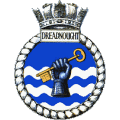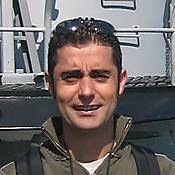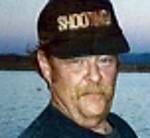You are viewing the archived version of the site.
Go to modelshipwrights.com for the current dynamic site!
Go to modelshipwrights.com for the current dynamic site!
1⁄700Build Up of the Tamiya 1:700 IJN Yamato
8
Comments
options...
The following pages cover optional components. If you are going for accuracy, the Yamato carried no planes or boats in the “Ten-Go” mission. I decided to add a few planes and boats to the model just to add interest. The kit only comes with two of each type of the planes the Yamato carried. Since the W fret with the kit is included with about every WW2 Japanese model made, I had a few extra planes I could use on the kit. Tamiya’s Heavy Vessel ordinance set is also the same fret as the one included in the kit.
Planes
There are two types of planes the Yamato carried. A floating biplane or “Pete” as it was called, and a single wing float plane called “Jake”. The plane components were first cut from the W fret and spray painted flat white on the undersides and all sides of the floats. After drying a few days the nose tips were cut off and saved, and the engine slightly drilled out for some detail. The molded on canopies were sanded off with a Dremel and sanding drum bit.
At this stage stretched sprue was used to make the four posts that would hold the upper wing of the biplane. The upper portions of the planes were then brush painted with Modelmaster Imp. Japanese Army Navy Green and the interiors a very light blue. I used thick clear stretched sprue for the “Jake” canopies. Since I did not have clear sprue to begin with, I used clear plastic utensils instead to make the clear stretched sprue.

The following photo shows the finished planes. Tom’s Modelworks photoetch propellers were added and all parts and paint have been added. About every situation the planes could be in was made. A clear circle punched styrene sheet was used instead of a propeller to give the illusion that the plane is getting ready for takeoff. Some stretched sprue was used for cables to make one “Jake” able to sit on the crane’s hook.
Gold Medal Models trolleys and shuttles were folded, painted then glued to the base as needed. The tail wire was made with stretched sprue for the base and smoke colored nylon thread for the wire, then painted black. I had a better decal set leftover from my Hasegawa Ise battlecarrier model and decided to use this for the plane decals. Some fine wing details on the Jakes was made from Tom’s Modelworks ladder that was cut in half.

With the planes done I carefully glued them to the tracks and crane of the ship. The plane with the working motor just had the shuttle underneath and will be glued onto the starboard catapult to look like it is getting ready for launch!

Comments
Thank you Anthony for sharing this incredible build with us. This is one of the finest ship models I've ever seen and in 700th scale no less! Your step by step instructions are much appreciated. There are enough construction tips there to keep me coming back over and over.
Thanks again Anthony for a majestic build and thanks Mark for posting.
Frank
JUL 20, 2008 - 02:36 AM
Hi Anthony
Thanks for writing this future reference great article!
I know that it is supposed to be used with the AOTS book (just "sitting" there looking at me), but I must say that you already have cut the path through the jungle - if I might use this way of expression!
Also I would like to make a small correction on a little thing and a challenge...
correction: you called the wooden thing on the stern a raft. It isn't, it is a emergency rudder;
challenge: you have gone the extra mile on this beauty, and although I could accept the water base for other model, in this particular case, I would say that it deserves a better one
Congratulations Anthony!!!
Rui
JUL 20, 2008 - 09:12 AM
Simply one of the best I've seen in a long time.
Thank you for sharing!
JUL 20, 2008 - 02:50 PM
Amazing workmanship there Anthony. Thanks for sharing and giving up all those tips and tricks. I know where I am going to be looking when I start working on my Musashi and Yamato models. One heck of a build and shows just what can be accomplished with the divine scale and some careful work.
JUL 20, 2008 - 04:51 PM
instant bookmark... just gorgeous,, hope my 350 nagato comes out 1/10th a s good as this one... will be watching and going over this one a long time, thanks for sharing!
JUL 22, 2008 - 11:24 AM
Thank you all for your replies. I really enjoy reading full buildup articles and thought I'd write one of a model I had a reference book and several sets of photoetch for. To spite several revisions I still can see alot of spelling/grammer errors I made in the document.
This model also recently won First place, Judges grand and several other awards in a local IPMS show, I was very pleased. Your right that I took the easy way out on the water and perhappes I'll practice and try one day on giving it a better base.
A reason this looked so good is that the kit itself is awesome. It comes with peices to build all versions of the Yamato. I'm going to be using it to build a 1944 Musashi in the future. If you want a good looking kit out of the box this is it. I highly recommend it.
JUL 22, 2008 - 12:59 PM
Indeed Anthony (I have both the Yamato and Musashi in the stash, waiting for better skills)
Thanks again
Rui
JUL 23, 2008 - 12:54 AM
Copyright ©2021 by Anthony Kochevar. _OPINIONS Model Shipwrights, KitMaker Network, or Silver Star Enterrpises. Images also by copyright holder unless otherwise noted. Opinions expressed are those of the author(s) and not necessarily those of Model Shipwrights. All rights reserved. Originally published on: 2008-07-20 00:00:00. Unique Reads: 39630












